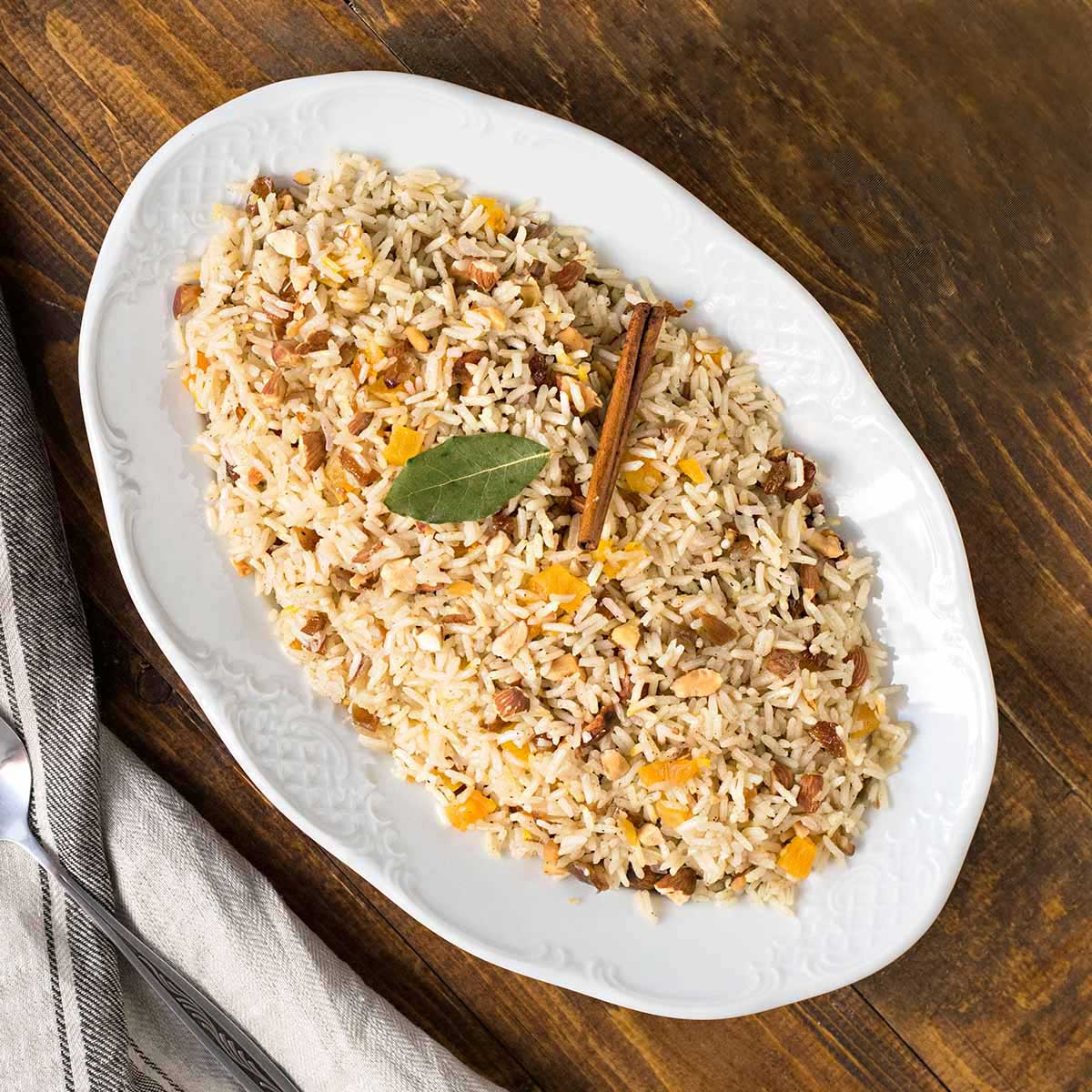Introduction
When it comes to elevating a simple meal into something memorable, the humble pilaf rice stands out as a timeless classic. Its origins trace back thousands of years, with variations across Middle Eastern, South Asian, Mediterranean, and Central Asian cuisines. The beauty of pilaf lies in its aromatic, fluffy grains that are infused with a rich tapestry of spices, broth, and sautéed aromatics, creating a side dish that is both comforting and sophisticated. This particular pilaf rice recipe, shared exclusively on Love With Recipes, combines the gentle warmth of cinnamon and cloves with the savory depth of broth and butter, resulting in a dish that pairs beautifully with a wide array of main courses—from roasted meats to hearty vegetarian options. The process involves meticulous attention to each step: washing the rice to achieve perfect fluffiness, sautéing aromatics to build flavor, and simmering gently to allow the grains to absorb all the nuanced flavors. The result is a fragrant, tender, and light rice dish that can serve as the centerpiece of your dinner table or a refined accompaniment to your favorite entrée.
Time
Preparation Time: 15 minutes
Cooking Time: 30 minutes
Total Time: approximately 45 minutes
Needed Equipment
- Fine-mesh strainer or colander
- Large saucepan with a tight-fitting lid
- Wooden spoon or heat-resistant spatula
- Measuring cups and spoons
- Knife and chopping board
- Kitchen towel or paper towels (for drying rice)
- Serving platter or bowl
- Optional: slotted spoon for serving
Tags
- Side Dish
- Rice
- Vegetarian
- Gluten-Free
- Flavorful
- Aromatic
- Elegant
Serving Size
This recipe yields approximately 4 servings, with each serving being a generous helping of fluffy, aromatic pilaf rice.
Difficulty Level
Intermediate — This recipe requires some basic cooking skills like sautéing, simmering, and careful timing, but it is accessible for home cooks with a moderate level of culinary experience.
Allergen Information
| Allergen | Present in Recipe |
|---|---|
| Butter | Yes |
| Broth (if chicken-based) | Potential allergen depending on broth type |
| Spices (Cinnamon, Cloves) | No common allergens |
Note: For those with dairy allergies or vegan preferences, substitute butter with plant-based margarine or oil, and use vegetable broth.
Dietary Preference
- Vegetarian: Yes (if using vegetable broth)
- Vegan: Yes (with substitutions for butter and broth)
- Gluten-Free: Yes
- Keto: No
Course
Side Dish
Cuisine
Middle Eastern / Mediterranean / Central Asian
Ingredients
Ingredient List in Table Format
| Ingredient | Quantity |
|---|---|
| Rice (preferably long-grain or basmati) | 300g |
| Cinnamon Stick | 1 |
| Cloves | 5 whole |
| Vegetable or Chicken Broth | 800ml (about 3 1/3 cups) |
| Butter (unsalted) | 70g (about 5 tablespoons) |
| Onion (large) | 1 |
Instructions
Step 1: Preparing the Rice
Begin by selecting high-quality long-grain or basmati rice. Rinsing the rice thoroughly is a crucial step to ensure that excess surface starch is washed away, preventing the grains from sticking together during cooking. Place the rice in a fine-mesh strainer or colander and rinse under cold, running water. Gently swirl the rice with your hand or a spoon to help remove the surface starch. Continue rinsing until the water runs clear. This process may take about 1–2 minutes. Once rinsed, transfer the rice to a clean kitchen towel or paper towels to drain thoroughly. Excess moisture can interfere with the rice’s fluffy texture, so allow the rice to dry slightly for about 5–10 minutes before cooking.
Step 2: Sautéing Aromatics
While the rice is draining, peel and finely chop the onion. Use a sharp knife to ensure uniform small pieces, which will cook evenly and release their flavor thoroughly. In a large, heavy-bottomed saucepan, melt the butter over low to medium heat. Butter provides a rich, mellow flavor and helps to create a non-stick surface for sautéing. Once melted, add the chopped onion. Sauté gently, stirring frequently, until the onions are translucent and soft—about 5–7 minutes. The goal here is to sweat the onions, allowing their natural sweetness to develop without browning or caramelizing. This step is foundational for building a flavorful base for the pilaf.
Step 3: Infusing with Aromatic Spices
After the onions have softened, add the cinnamon stick and whole cloves to the pan. These spices are key to imparting the warm, fragrant aroma characteristic of traditional pilaf rice. Stir them into the onions and butter mixture, allowing their fragrant oils to release—a process that takes about 1 minute. Be attentive: spices release their aroma quickly, and burning them could introduce bitterness. Stir gently to coat the onions and to ensure even distribution of the spices. The cinnamon and cloves will infuse the butter and onions with their aromatic essence, creating a fragrant base for the rice.
Step 4: Toasting and Coating the Rice
Add the drained rice to the pan, stirring to coat each grain with the butter, onions, and spices. This step is essential for toasting the rice lightly, which enhances flavor and texture. Toast the rice for about 2–3 minutes, stirring constantly, until the edges of the grains become slightly translucent and start to turn a faint golden hue. This toasting process also helps to prevent the rice from sticking together during cooking, ensuring each grain remains separate and fluffy.
Step 5: Adding Broth and Bringing to a Boil
Pour in the broth, making sure it covers the rice completely. The ratio of broth to rice is approximately 2.66:1, which is ideal for fluffy, tender grains. Before adding the broth, you might want to taste it to ensure it’s well-seasoned; salt can be added if necessary. Increase the heat to medium-high and bring the mixture to a vigorous boil, uncovered. This step takes about 5–7 minutes. As the liquid boils, the flavors from the spices, butter, and onions will meld, infusing every grain of rice with aromatic richness.
Step 6: Simmering and Absorption
Once boiling, reduce the heat to the lowest setting and cover the saucepan with a tight-fitting lid. Allow the rice to simmer gently for 15–20 minutes. During this time, avoid lifting the lid or stirring, as this can disrupt the steam process necessary for even cooking. The rice should absorb all the liquid and become tender yet fluffy. Check the rice at the end of the cooking period; if there’s any residual liquid, let it simmer uncovered for a few more minutes until fully absorbed.
Step 7: Steaming and Resting
After the cooking time, remove the saucepan from heat, but keep it covered. Let the rice rest for an additional 5 minutes. This resting phase allows the steam to evenly distribute and finish cooking the grains, ensuring maximum fluffiness. During this period, the rice grains will firm up slightly and become even more separate and light. Remove the cinnamon stick and cloves carefully, either by hand or with a slotted spoon, to prevent any unwanted spice fragments in your final dish.
Step 8: Fluffing and Serving
Using a fork, gently fluff the rice to separate the grains, taking care not to mash or break them. Fluffing introduces air into the rice, making it lighter and more appealing. Transfer the pilaf rice to a serving platter or bowl. Serve hot, garnished with additional herbs or spices if desired. This aromatic rice pairs beautifully with roasted meats, stews, grilled vegetables, or even vegetarian main dishes like grilled eggplant or stuffed peppers. Its fragrant aroma and tender texture make it a versatile and elegant addition to any meal.
Preparation Tips
- Choose high-quality rice: Long-grain or basmati rice yields the best fluffy texture. Rinsing thoroughly is essential to remove surface starch.
- Adjust seasoning: Salt can be added during the broth addition step to enhance flavor. For a slightly sweeter touch, a pinch of sugar can be incorporated during sautéing.
- Spice variations: Feel free to add other spices like cardamom, bay leaf, or star anise for additional complexity.
- Make ahead: The pilaf can be prepared a few hours in advance, then gently reheated, adding a splash of hot broth if necessary to restore moisture.
- Presentation: Fluff the rice thoroughly and serve on a warm platter for an inviting presentation.
Nutritional Information
| Nutrient | Per Serving (approximate) |
|---|---|
| Calories | 275 kcal |
| Protein | 5 g |
| Fat | 13 g |
| Carbohydrates | 38 g |
| Fiber | 1 g |
| Sodium | 700 mg |
Tips and Tricks
- Use quality broth: The broth’s flavor heavily influences the final dish. Homemade broth provides the best depth, but store-bought works well too.
- Control the heat: Maintain a gentle simmer during the cooking process to prevent burning or uneven cooking.
- Don’t lift the lid: Keeping the lid on during simmering ensures steam stays trapped, cooking the rice evenly.
- Flavor layering: Consider adding toasted nuts or dried fruits during serving for additional texture and flavor.
- Spice infusions: For a more intense spice flavor, toast the spices briefly before adding to the onions.
Add-ons
- Chopped fresh herbs (parsley, cilantro, mint)
- Toasted nuts (almonds, pistachios, pine nuts)
- Dried fruits (raisins, apricots, cranberries)
- Grated lemon zest for added brightness
- Feta or crumbled cheese for a savory contrast
Side Dishes
- Roasted or grilled meats (chicken, lamb, beef)
- Vegetable stews or curries
- Grilled vegetables or vegetable kebabs
- Fresh salads with tangy dressings
- Yogurt-based dips (tzatziki, raita)
Improvements
- For extra flavor, sauté garlic or ginger along with the onions.
- Experiment with different types of rice such as jasmine or sushi rice for varied textures.
- Use homemade broth with herbs and vegetables for a more nuanced flavor profile.
- Try adding saffron strands soaked in warm water for a luxurious color and aroma.
- Include sautéed vegetables or protein such as chicken or chickpeas for a complete one-pot meal.
Save and Store
Leftover pilaf rice can be stored in an airtight container in the refrigerator for up to 3 days. To reheat, add a splash of hot broth or water, cover, and microwave or warm on the stovetop until heated through. For longer storage, freeze in portioned containers for up to 1 month. Thaw in the refrigerator overnight and reheat as described. To maintain optimal texture and flavor, avoid reheating multiple times.
FAQ
Can I make this recipe vegan?
Absolutely. Substitute the butter with plant-based margarine or olive oil, and use vegetable broth instead of chicken broth. The flavor remains rich and aromatic.
Can I prepare this in advance?
Yes, you can prepare the pilaf a few hours ahead. Store in the refrigerator and reheat gently, adding a little hot broth to restore moisture if needed.
What rice is best for pilaf?
Long-grain or basmati rice is preferred for its fluffy texture and ability to absorb flavors well.
How do I prevent the rice from sticking together?
Rinsing thoroughly, toasting the rice before cooking, and cooking with the correct broth-to-rice ratio are key factors in achieving fluffy, separate grains.
Can I add other spices?
Yes. Feel free to experiment with cardamom, bay leaf, star anise, or cumin to customize the flavor profile.
Conclusion
This pilaf rice recipe encapsulates the artistry of simple ingredients combined with precise technique to produce a dish that is both aromatic and satisfying. Its fragrant spices, tender grains, and rich broth create a versatile side that elevates any meal, making it suitable for both everyday dinners and special occasions. The process of washing, sautéing, and simmering ensures each grain is infused with flavor and cooked to perfection. As a staple in many cuisines, pilaf’s adaptability and comforting qualities have made it a beloved dish worldwide. Whether served alongside roasted meats, vegetables, or as part of a larger feast, this pilaf is guaranteed to impress with its fragrant aroma and delicate texture. Remember, the key to success lies in quality ingredients, patience during cooking, and a touch of personal flair in seasoning and presentation. Enjoy crafting this timeless dish, and delight in the rich flavors that come from carefully layering aromatics and spices, creating a truly memorable side dish that complements any meal.
References
- “Pilaf: History and Variations,” Culinary Heritage Journal, 2018.
- “The Science of Rice Cooking,” Food Science Review, 2020.




